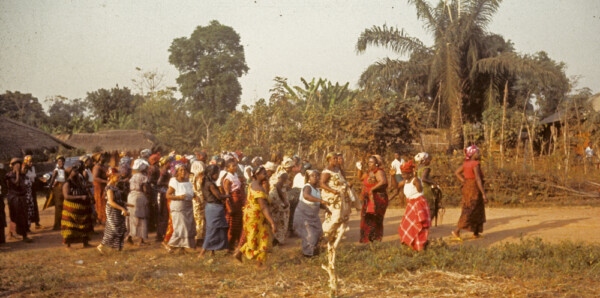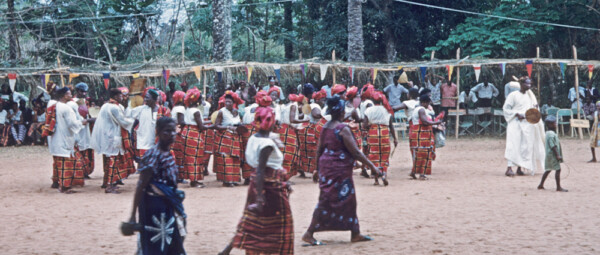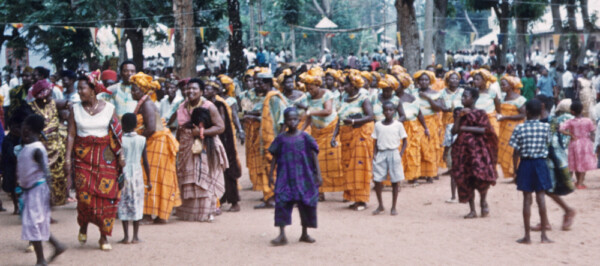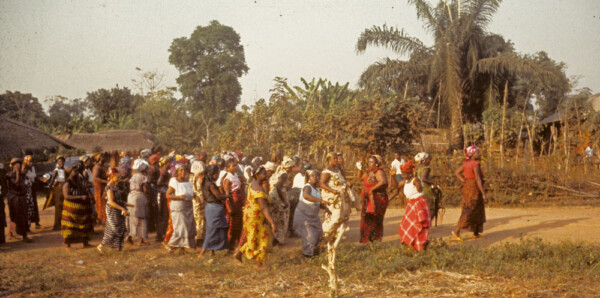I select this example of a burial ritual not because it illuminates the full details of funerary process (it does not), and in fact when we arrived on the scene it was the third day of the rituals. I do this because it highlights some very important aspects of Ndi-Onicha society , seen for example in the image at the top of this page.
The Agbu family comes from the Ogbo family of Umuase (the same division as Onowu [“prime minister”] Anatogu),, the father (the newly-deceased) having raised three sons of considerable distinction — first a Senior Clerk, , second the Editgor of the West African Pilot, and third a barrister (as well as other worthy children). The barrister (who typically lives in Onitsha Waterside, escorted us to a house allocated to him for the duration of the funeral, where he and a few close relatives received visitors coming because of their special connections to him.
Our host then took us to the house where the deceased had died. At left inside the entry was the bed on which he had lain, now covered with expensive white cloth,with a photograph of the man in life propped up in the center. Seated around the bed were a group of very elderly women — the most senior Daughters (Umu-ada)) of Umu-Ase, and also a number of Daughters from the deceased’s mother’s village (Ogbeozala).
We were escorted into two other rooms of the house, each occupied by one of the deceased’s two wives. In each the wife sat on the bed, while Daughters of her village sat on mats on the floor beside her., six in one room, 15 in the other.
Outside and across the street, in front of another house there sat another group of about 20 middle-aged Daughters, “inactives”, who were watching the young Daughters of Ogbeozala dancing in a circle:

Meanwhile, yet another contingent of Umuase Daughters, the “young actives”, were dancing and singing around various parts of Enu-Onicha, doing Igba-ilo — a surging crowd:

We were told this group included some friends of particular Daughters, and also some of the elderly members who “felt strong.”
We were told that food was provided for the Daughters — for three days for those staying inside, for two days for those outside. This meant as substantial amount of rice, and a huge amount of “foo-foo’ — the pounded guinea yam that constitutes a central food in traditional Onitsha. After the Daughters had departed from the immediate scene this afternoon, we found many plates full of foo-foo lying about in the grass, many barely eaten at all . The Barrister commented, the Daughters demand in detail their rights to specific amounts of food, then they throw out whatever they don’t want.
.………………………………..
The deceased might well have been buried inside his house, but he was not. Instead he had been buried outside it, in a location where a high mound had been raised up to denote the fact. Barrister Agbu explained that this location had been the site of his father’s “Great Ancestral house” (nnukwu iba), and due to come complications of the descent group’s history it was important for the surviving Agbu brothers to make this burial to stake a claim in part of the group’s structure of authority. These matters need not detain us here.
………………………………………..
Instead I want to return to what is surely the most remarkable feature of this funeral: the astonishing number (and importance) of women in the funerary process. Men are of course important (and in many ways directive, authoritative figures), but the overwhelming massiveness of the female presence.
Women have an array of important roles in Onitsha society: as wives, of course, but as mothers, and as daughters, they provide very important links between different corporate descent groups. One’s mother is the Daughter of an important linking descent group that provides protection to you. And to a descent group member, Daughter’s Children are very important people to you. Within a descent group, Daughters enact powerful (and corporately organized) roles. Between descent groups, Mother’s People are one’s powerful allies. So linkages made through women are very important to both males and females.
Add to this then the fact that, historically, Onitsha men have exercised unusual opportunities to engage in productive work outside the community, while Onitsha women have had much less opportunity to do this. And for Onitsha women, the alternative opportunity of engaging in trade has been largely superseded by the [invasion] of outsider, Ndi-Igbo men. I found, looking at local Inland Town populations, a great scarcity of career-age men (though larger numbers of youths and retired male elders), while lots of women of all ages, most having marginal economic opportunities .
The difference was visibly obvious in the “Age-Grade” (ogbo) organizations . These are open (since modern times) to both males and females within the three-year age span. I managed to photograph two of these as they performed at Obi Okosi II’s funeral:

In this group-dancing configuration, the ratio of women to men is something like 8 to 3. Ogbo [Douglas] was formed of people born in the three-year period around 1918, so in 1961 these people were in their forties. Some of the men of course had full-time jobs in Onitsha, but the absence of others seems obvious.
My second example records a group whose name I failed to catch, but the ratio looks even higher:

I rest my case. Interestingly, the “Non-Onitsha Ibos” — mainly traders and students living part-time in Onitsha but retreating to their nearby towns for much of their commited social life — have the opposite pattern. In Onitsha, most of them (not all, it must be emphasized) lived in mainly-male quarters. I recall a visit to Fegge, where on a Sunday people were out walking around in their finest:

